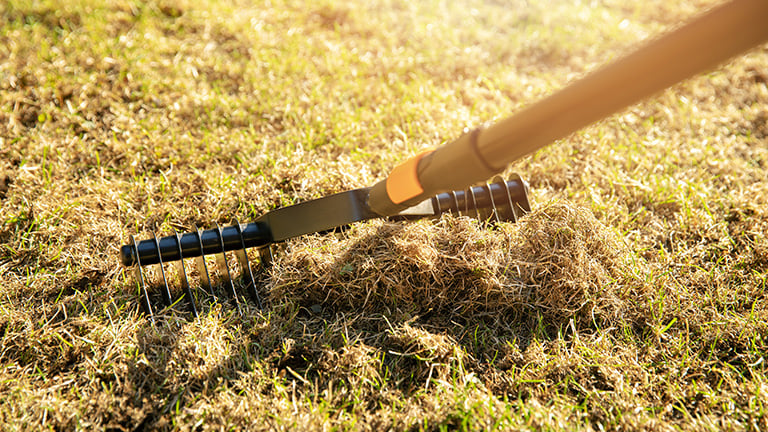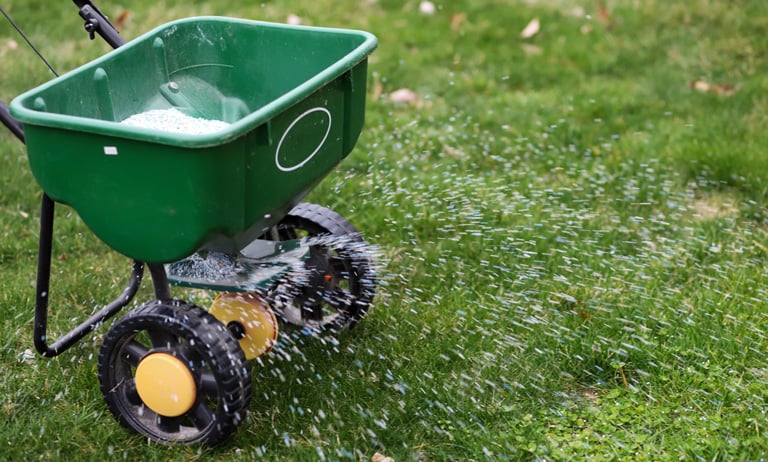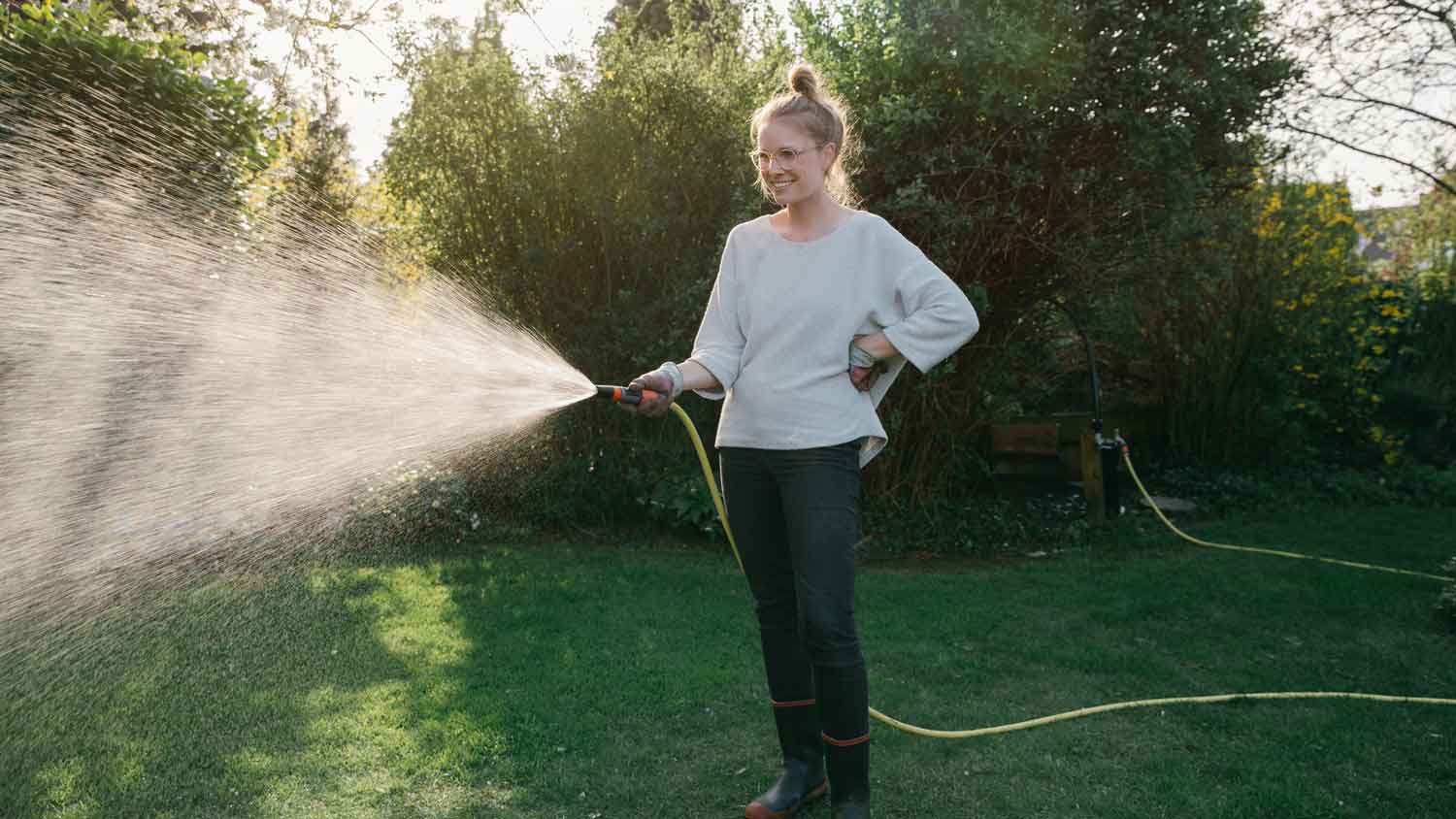Spring Lawn Care: 15 Easy Steps to a Beautiful Yard
Take the guesswork out of keeping your lawn pristine throughout the growing season


Spending a few hours on your lawn in the spring saves you time and effort later in the season and ensures your grass is as lush and dense as possible. By keeping out weeds and boosting your lawn’s health, you’ll have a luxurious outdoor space for all of your summer and fall fun. Follow our spring lawn care checklist with tips for each task to experience your best lawn ever.
How to Do Spring Lawn Care Like a Pro
Head outside with your garden gloves, sun hat, and an upbeat playlist. Get ready to tackle a few lawn care tasks that’ll elevate your outdoor space all season long.
1. Remove Debris and Rake Leaves

Cleaning up leaves and debris in the spring ensures your grass doesn’t get smothered, which can cause dead spots in your lawn. Having a clear lawn also allows your soil to get maximum sun and water, helping your grass to be full and green. Here’s how to properly clean up your lawn:
Pick up fallen twigs, branches, and pieces of trash from your yard.
Place the debris in buckets as you go and dispose of them in a yard waste container or trash can.
Rake leaves into a pile and put them into your compost, or mulch them and spread them on your grass or garden to give your soil extra nutrients.
Alternatively, you can use a leaf blower. Some leaf blowers have a reverse setting, allowing you to suck up leaves and mulch them.
2. Dethatch Your Lawn
Lawn thatch is organic material such as leaves, roots, and dead grass that has built up on your lawn and is deeper than half an inch. While a thin layer can naturally protect the soil and grass, a thicker amount can smother your grass, acting as a barrier to sun and water and preventing new seeds from taking root. Here’s how to dethatch your lawn:
Make sure to dethatch your lawn before the first mow of the season.
With a dethatching rake or machine, remove the thatch and add it to your compost (if you don’t use chemicals on your lawn) or dispose of it.
Wait until your lawn is green to dethatch to ensure the roots are strong. Dethatching too early can cause damage to the growing roots.
Additionally, avoid raking when your soil is soft or muddy, as you could pull up healthy grass crowns.
3. Assess the Soil’s pH
Each type of grass grows best with soil that has the right nutrients and pH. Most grasses grow well with a pH between 6 and 7, but some can grow with a pH as low as 5.5 or as high as 7.5. Testing your soil early in the season allows you to select the right fertilizer that will improve the quality of your soil and prevent weeds, fungi, and pests. Here’s how to properly test your soil’s pH:
You can test your soil’s pH with a home testing kit or ask for a test from a local cooperative extension office.
Your local office can also provide educational resources about your soil, lawn, and garden, such as the best time to apply herbicide in your area.
Retest your soil’s pH once per year. When your soil is balanced, you can test once every three years.
4. Fertilize Your Lawn

After your second mow or once your grass has been green for three weeks, fertilize your lawn with compost, mulched lawn clippings or leaves, or commercial fertilizer. If you fertilize too early, you risk feeding weeds. Here’s how to fertilize your lawn for greener, healthier grass:
Water your lawn two or three days before applying fertilizer to ensure it’s damp and absorbs the fertilizer without burning the grass roots.
Use a spreader (you can rent them from most home improvement stores) to ensure that your fertilizer is spread evenly across the lawn—you can achieve this by going back and forth evenly across your lawn—and you won’t end up with a patchy yard.
If you test your soil, your results indicate what nutrients your grass needs, specifically nitrogen (N), phosphorus (P), and potassium (K). Each fertilizer has an NPK rating, so you can match the ingredients to what your lawn needs.
5. Apply Pre-Emergent Herbicides
If your lawn is susceptible to weeds, applying a pre-emergent will be one of the most important parts of your spring lawn care checklist, as pre-emergent kills weeds before they can root and grow. Sometimes, you can get fertilizer that also has a pre-emergent herbicide in it, allowing you to apply both at the same time. Here’s how to apply pre-emergent herbicides:
Apply your pre-emergent herbicide evenly across your lawn once the ground temperature has stayed above 55 degrees Fahrenheit for 48 hours or longer.
Water your grass within the next three days to ensure the pre-emergent seeps down to the roots.
Follow up with regular weed and feed after eight weeks to give your lawn an extra weed-killing boost.
Don’t skip applying a pre-emergent; missing this step means your lawn might get weeds like crabgrass that are nearly impossible to get rid of later in the season. However, if you have crabgrass, you can apply a fertilizer with a crabgrass preventer to stop the growth.
If weeds have already started growing, you’ll need to apply a post-emergent herbicide. Contact your local extension office or a local weed control pro if you’re unsure about the timing of your herbicides.
6. Aerate Your Lawn
If you decide not to apply pre-emergent herbicides, you can aerate your lawn to help your grass breathe, absorb water and nutrients, and loosen compacted soil. Here’s how to aerate your lawn:
Use a manual aerator on a small or mid-size lawn or rent an aerator from a home improvement store for a lawn over 1/2 acre. Aeration is especially valuable for lawns that get lots of traffic or that have soil with a high clay content.
If you apply pre-emergent this spring, wait to aerate your lawn until the fall. If you aerate too soon after you apply pre-emergent, you’ll likely end up puncturing the pre-emergent’s chemical shield, making it ineffective.
The best times to aerate cool-season grasses are in early spring or fall.
For warm-season grasses, aeration is best in late spring to summer.
Most lawns need aeration once every two to three years. However, if your lawn is highly trafficked, you’ll need to aerate it once per year.
7. Overseed Bare Spots
If you have patchy spots in your grass, you can overseed the bare areas to restore your yard. Here’s how to overseed:
Cut the grass in the area as low as you can and cultivate any exposed soil to ensure the new seeds take root.
Apply a slow-release nitrogen fertilizer along with your seeds to prompt growth.
Keep the new seeds moist until they’re actively growing, watering them every day for at least two weeks.
Once the new grass reaches 2 inches high, you can mow over the former bare spots.
Additionally, you should avoid walking on newly seeded areas and only mow the grass once you actually need to. You can also overseed in the fall.
8. Add Amendments
You may want to apply sulfur or lime amendments to your soil to enhance grass growth. Based on the pH of your soil, determine what amendments you need to add. Limestone can raise your soil’s pH, while sulfur can lower it with several applications over time. Here’s how to add amendments to your lawn:
Add lime amendments during the spring and fall.
You can purchase bags of sulfur and lime amendments at most local home improvement stores.
Add between 35 and 56 pounds of sulfur per 1,000 square feet of soil.
For lime amendments, add 50 pounds per 1,000 square feet of soil.
9. Weed the Lawn
If you see weeds emerging, you’ll want to eliminate them at the start of spring lawn care season. Here’s how to remove weeds from your lawn:
Dig weeds out at their roots with a hand shovel and dispose of them.
If you have dandelions, be sure to cut off the flower stems before they produce seeds.
Spot spray or weed the lawn before each mow to keep your lawn healthy and weed-free.
10. Tune Up the Lawnmower

Get your mower ready for the season by performing an inspection and maintenance. Here’s how to tune up your lawn mower for spring lawn care season:
Turn the mower on to make sure it's running smoothly.
Change the oil.
Fill the gas tank.
Check the spark plugs.
Sharpen the mower blade to ensure you cleanly cut your lawn instead of tearing the grass and turning it brown. Always turn off your mower first, disconnect the battery (if applicable), disconnect the spark plug, and put on safety goggles and gloves before working on the blade.
You can sharpen your mower blade with a file, blade sharpening kit, or angle grinder.
If you use a file, place the blade in a vise and stroke the blade with a 10-inch metal file downward at a 45-degree angle.
Keep filing the blade until the edge is as sharp as a butter knife, up to about 50 strokes. Repeat on the other side.
When working with lawn fertilizer and other chemicals, take measures to prevent the products from contacting your skin and eyes. Be sure to wear protective gear like gloves and a dust mask to stay safe.
11. Mow High
Mowing your lawn is an essential part of your spring lawn care routine. Here’s how to mow your lawn correctly:
Begin mowing once the grass is dry and the blades are long.
Try to mow your lawn during the evening once all the morning dew has thoroughly dried.
You should cut most grass varieties to be three to four inches tall, often the highest setting on your mower. But some grasses, like Bermuda and Zoysia, need a shorter cut.
Aim to cut the top third of your grass’s height. Longer blades of grass encourage deeper, healthier roots. If your grass is too short, more sun can reach the soil, prompting more weeds to germinate.
Prevent ruts by changing the pattern each time you mow.
At the beginning of the spring season, mow once every five days to keep your lawn thick and green.
12. Trim Your Perennials
If you didn’t trim your perennials, such as ornamental grasses, bushes, or flowers, in the fall, trim them with pruning shears in early spring before any new growth starts.
You should cut most plants to five inches above the soil line, but check your exact variety. If you wait to trim until new growth happens, you can damage or stunt the growth.
Add the clippings to your compost pile.
13. Plant Your Annuals
If you want annual flowers, such as marigolds, zinnias, and impatiens, spring is a great time to plant them. If you're planning on planting a garden full of vegetables, plant your seeds and seedlings in the spring. Surround your budding plants with a weed preventer, such as grass clippings or mulch, to make weed maintenance easier throughout the year.
14. Water the Lawn and Garden

Keeping your lawn moist during the spring lawn care season is essential to maintaining a beautiful yard. Here’s how to water your lawn for the best results:
Before the spring season begins, choose a watering method—such as an irrigation system, sprinkler system, or garden hose.
Most grass varieties need 1.5 inches of water per week, including rainfall.
Set up a lawn watering schedule and stick to it starting in the spring.
Water before 10 a.m. to avoid water evaporation.
Be sure to water your flowers and vegetable garden regularly, especially during their initial growth.
15. Spread Mulch
Once temperatures are warm and short sleeves start coming out, it’s time to apply mulch to refresh your landscaping and keep out weeds. Here’s how to add mulch to your garden beds:
Ensure your garden beds are ready for fresh mulch by pruning bushes, hedges, and branches.
Edge your flower beds with a half-moon edger or a garden spade so there is a proper barrier between your garden beds and the lawn.
Add about two to three inches of mulch around your plants and in your garden beds.
Choose a type of mulch that matches your home’s aesthetic.
Spring Lawn Care Tips
To enhance your outdoor space, follow these pro tips starting in the spring and going all the way through the fall.
With a string trimmer (also known as a weed eater or weed wacker), edge your yard along your sidewalk, driveway, and garden beds for a crisp look.
Identify the weeds plaguing your lawn so you can control and kill the weeds each year.
Dethatch your lawn and aerate your soil so your grass can thrive and get nutrients and sun.
Keep your grass blades high and your mower blades sharp.
Mix up your mowing pattern to reduce wear on your grass.
Repair bare spots by overseeding or planting sod.
Opt for tree trimming before the spring season begins so you don’t need to worry about dead branches falling on your lawn.
If your lawn has a lot of large brown patches, consider laying sod at the beginning of the spring season.
How Much Does It Cost to Do Spring Lawn Care?
Spring lawn care costs range from $35 to $1,700, depending on what tasks you want to tackle. This range could include anything from weed killing to fertilization, aeration, or leaf removal. You can hire a lawn treatment pro near you to tackle pieces of the project or handle it yourself with the right lawn care tools.
DIY vs. Hiring a Pro
You can tackle spring lawn care yourself with the right tools and a little time. If you prefer not to get your hands dirty or you want an expert opinion on your lawn, reach out to a local lawn care service. They’ll assess your grass and property to determine the best approach to handle your weeds and ensure you’re able to enjoy the lushest lawn all season long.
Why Do I Have to Do Spring Lawn Care?
Tackling spring lawn care reduces the yard work you’ll have to do later on and boosts the strength and appearance of your lawn. While it can be tempting to put off spring chores, they can make all the difference for your summer and fall enjoyment.
Less Maintenance All Year
Preventing weeds in the spring keeps them at bay during the summer and fall. Fertilizing your lawn enhances the strength and density of your grass, saving you work down the road.
Enhances the Appearance of Your Lawn
When you aerate, fertilize, and water your lawn in the spring, it’ll be greener and lusher for the remainder of the season. Healthier grass also boosts your home’s curb appeal and your enjoyment of your outdoor space.
Helps Prevent Weeds, Pests, and Fungi
When you apply herbicide and allow for strong grass growth from the beginning, you’ll have a lusher, denser lawn. Healthier grass is more likely to keep out weeds, pests, and plant fungi.
Kelly Weimert contributed to this piece.
Frequently Asked Questions
You should put pre-emergent herbicide and fertilizer on your lawn in the spring. Pre-emergent herbicide keeps weeds from taking root. Fertilizer helps your grass to grow lush and dense and blocks future weeds from growing. You can also add amendments, such as sulfur and lime, to enhance your soil quality.
You should fertilize your lawn after it has grown at least two inches or after your second mow (usually in March or April). Applying fertilizer too early can feed your weeds and cause them to grow stronger, too. You should water your lawn two to three days before you apply fertilizer to ensure the soil absorbs it.
In the fall, you should aerate the soil, overseed the bare spots, kill weeds, mow the lawn low, and rake your leaves. By boosting your lawn’s health in the fall, your grass will be stronger throughout the winter and come back healthier in the spring. You should also trim your perennials so that they withstand the winter and are ready for new growth in the spring.





- 9 Fall Lawn Care Tips for a Healthy, Thriving Yard
- How To Make Grass Green: Become the Envy of the Neighborhood
- Who To Call for Lawn Problems: A Complete Guide
- Why Is My Grass Turning Yellow? 15 Solutions to Try
- Here Comes the Sun: 9 Tips for Spring Lawn and Landscaping Care
- Can You Overwater Grass? How to Avoid This Common Mistake
- 12 Tips for Taking Care of Your Backyard, From Pruning to Weed Prevention
- How Long to Water Grass for a Lush Lawn—and How Often to Do It
- A Lawn Fertilizer Schedule to Follow for Best Results
- 10 Easy Ways to Save Money on Lawn Care












